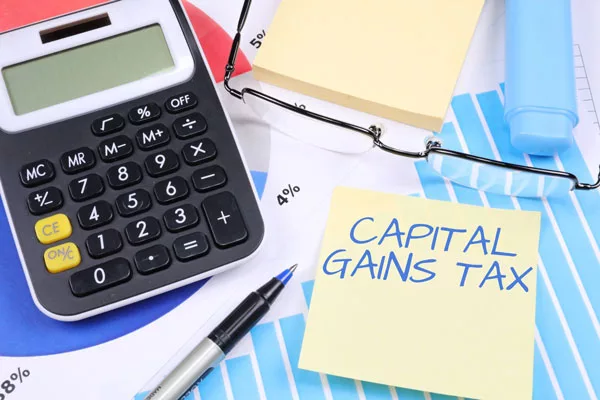Understanding Capital Gains Tax: A New Guide to Tax-Efficient Investing
- Introduction
- Capital Gains Tax Explained
- Tax-Efficient Investing: The Buffet Analogy
- Best Tax-Advantaged Investments
- Taxable Accounts and Their Nuances
- Tax-Efficient ETFs and Mutual Funds
- Conclusion
- Frequently Asked Questions
Introduction
Understanding Capital Gains Tax” might sound like the title of the world’s most boring book, but stick with me. This topic is important, especially if you’re nearing or in
Think of it as the unsung hero of the financial world, lurking in the background but playing a big role in how much of your hard-earned money you get to keep.
And while we’re on the topic of keeping things, where does that one sock always disappear to after doing laundry?
But I digress. Let’s get into the world of capital gains tax and how it affects your investments
Capital Gains Tax Explained
Capital gains tax, in a nutshell, is the tax you pay on the profit from selling something that’s increased in value.
Think of it as the government’s way of saying, “Hey, good job on that smart investment! Now, share a little, will you?”
There are two main types: short-term and long-term. Short term capital gains, which result from selling assets held for less than a year, are taxed at your ordinary income tax rate, which is usually higher than the rate for long-term gains. The former applies to assets held for less than a year and is usually taxed at a higher rate, while the latter is for assets held for more than a year and gets a better tax rate. Understanding the tax rates applied to different types of gains is key to tax planning.
Tax-Efficient Investing: The Buffet Analogy
Now, if you’re a high earner, understanding the implications of capital gains tax is crucial. It’s like knowing where the speed cameras are on a highway.
You can drive fast, but you need to know where to slow down. Tax-efficient investing is your roadmap to minimizing the tax on your investments. It’s not about avoiding taxes but making smart decisions that align with tax laws
So, what is tax-efficient investing? Imagine you’re at a buffet. You’ve got a plate, and you want to fill it up with the most delicious food without overpaying. Tax-efficient investing is about filling your investment plate in a way that you get the most returns for the least tax cost.
Smart asset allocation—dividing your investments among different asset classes like stocks, bonds or municipal bonds—can help you achieve your investment goals while minimizing taxes. Knowing your investment goals and the types of asset classes you have in your portfolio is key to building a tax-efficient investment strategy. It’s about being smart and knowing which investments offer the best tax benefits.
Best Tax-Advantaged Investments
Speaking of benefits, let’s get into some of the best tax-advantaged investments out there.
Municipal bonds, for example, are a favorite among many retirees. Municipal securities, such as municipal bonds, are often chosen for their tax benefits, as the interest from these bonds is usually exempt from federal taxes and, in some cases, state taxes.
But like all investments, they come with their own set of pros and cons. While they offer tax benefits, they might not provide as high returns as other taxable investments.
In addition to municipal securities, investors can also use tax-advantaged accounts such as IRAs and 401(k)s, as well as tax deferred accounts, to defer or reduce taxes on investment gains. Knowing the tax treatment of different investments and accounts is important for maximizing after-tax returns.
Taxable Accounts and Their Nuances
Now, let’s talk about taxable accounts. Taxable accounts, such as taxable brokerage accounts, are standard brokerage accounts where any investment income and capital gains are taxed annually. Income generated in these accounts, such as dividends and capital gains, is considered taxable income and adds to your annual tax bill. Managing investments in taxable accounts strategically can help reduce your overall tax burden in retirement.
The trick here is to choose the right investments for these accounts. Think long-term holdings that generate capital gains, which are taxed at a lower rate than ordinary income.
Tax-Efficient ETFs and Mutual Funds
For those who love to get into the investment deep end, tax-efficient ETFs (Exchange Traded Funds) and mutual funds are popular investment vehicles for building a diversified investment portfolio. Mutual funds are pooled investment vehicles managed by mutual fund managers or fund managers, who buy and sell securities to meet the fund’s investment objectives. Most mutual funds are actively managed funds, meaning mutual fund managers make frequent trades to try to beat the benchmark, which can generate more taxable events and higher management fees.
In contrast, ETFs are often passively managed and ETFs tend to generate fewer taxable events due to their structure and how ETF managers handle inflows and outflows. ETFs trade on an exchange throughout the day, while mutual fund shares are bought and sold at the net asset value (NAV) calculated at the end of the trading day, based on the net asset of the fund.
Expense ratios and management fees are important considerations—ETFs tend to have lower expense ratios than most mutual funds, which can improve overall tax efficiency. Mutual fund tax efficiency is often lower because mutual funds distribute capital gains taxes to mutual fund investors when they sell securities within the fund. Investment advisors often recommend ETFs over mutual funds for investors looking for tax efficiency from a tax perspective.
The underlying securities and underlying investments in both mutual funds and ETFs impact their tax treatment and the frequency of taxable events. Index mutual funds and index mutual fund investments can be more tax efficient than actively managed funds due to lower turnover and fewer taxable events. Dollar cost averaging is a strategy for investing in mutual funds and ETFs that can help manage risk and build wealth over time.
Emerging markets ETFs have unique tax considerations, such as restrictions on in-kind transfers, which can affect their tax efficiency. Qualified dividends from ETFs and mutual funds held in taxable accounts can be taxed at lower tax rates, improving after-tax returns. Maintaining your target asset allocation across taxable and tax advantaged accounts is important for optimizing tax efficiency.
Investors should consider their overall mutual fund investment, tax treatment and consult with professionals or file taxes accurately to optimize outcomes.
Conclusion
In summary, being tax efficient is not a one-time task. It’s an ongoing process.
Regular reviews, staying up to date with changing tax laws and consulting with financial professionals can ensure your investments are as tax efficient as possible.
In conclusion, understanding capital gains tax and the nuances of tax efficient investing can make a big difference in your retirement finances. It’s like having a secret recipe that makes everything taste better.
And while we’re on the topic of secrets, have you ever considered sharing your wisdom through blogging? Word on the street is it’s the new gold rush of 2025. And with a sprinkle of AI magic, who knows where it might lead?
Frequently Asked Questions
What is Capital Gains Tax?
Capital Gains Tax (CGT) is a tax on the profit you make when you sell or dispose of an asset that has increased in value. It’s the gain you make that’s taxed, not the amount of money you receive.
How is tax efficient investing related to Capital Gains Tax?
Tax efficient investing involves strategies to reduce the impact of taxes on your investment returns.
By understanding and planning for capital gains tax you can make decisions that might lower your tax liability.
Are all capital gains taxable?
No, not all capital gains are taxable and you can legally reduce or even eliminate capital gains tax in some situations, depending on the type of asset, how long you’ve held it and specific tax laws in your country.
What are tax efficient ETFs and mutual funds?
Tax efficient ETFs (Exchange Traded Funds) and mutual funds are designed to minimize tax liabilities.
They do this by limiting the amount of buying and selling within the fund or by strategically selling certain assets at a loss to offset gains.
How do I determine the best investments for my taxable accounts?
You need to consider the tax implications of any investment.
Generally tax efficient investments like index funds, ETFs and tax managed funds can be suitable for taxable accounts.
But always consult with a financial advisor to determine the best fit for your situation.
Can I offset my capital gains?
Yes, one common method is to sell investments that have lost value to offset the taxable gain.
This is called tax loss harvesting. Another option is to hold onto investments for over a year (in many jurisdictions) to qualify for a lower long term capital gains tax rate.
What are the safest tax free investments?
Some of the safest tax free investments include municipal bonds or “munis.”
The interest from these bonds is typically exempt from federal income tax.
But safety and tax implications can vary so do your research or consult with a financial professional.
How often do tax laws and regulations change?
Tax laws and regulations can change annually depending on legislative actions.Make sure to stay up to date or work with a tax professional to be compliant and take advantage of any new tax benefits.
Can I avoid capital gains tax if I reinvest the profits?
In some cases reinvesting profits can defer capital gains tax but it doesn’t typically eliminate the tax liability.
Rules and exceptions apply so consult with a tax professional about your situation.
Remember these are general answers, always consult with a tax or financial professional about your situation.



